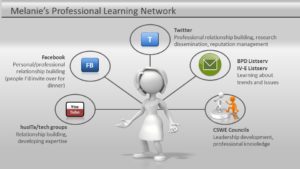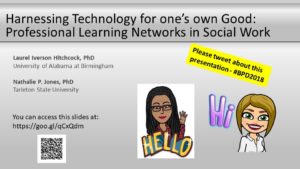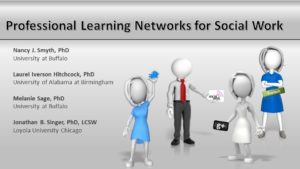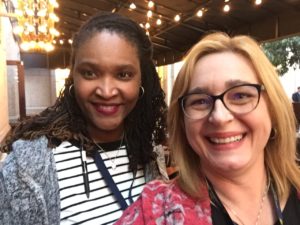#husITa18/#SWSD2018: Sustaining lifelong learning through the use of Technology-Mediated Professional Learning Networks
On Friday July 6, 2018 at 3:15 PM in the Exhibition Hall at the 2018 International Social Work, Education & Social Development Conference, Melanie Sage, Nancy J. Smyth, Jonathan Singer, and I are presenting a poster about how social workers can use technology for career-long learning, specifically by creating a Professional Learning Network (PLN).
Simply stated, PLNs employ, within an online environment, the same strategy that social work professionals have used for centuries: the practice of connecting to people who share interests and can learn from each other. PLNs are a well-established practice in the field of education (Richardson & Manacebelli, 2011). The term comes from the educational technology learning communities and has its origins in Connectivism, a learning theory developed by George Siemens (2005) to explain how network-based learning occurs in the digital age. Specifically, Connectivism suggests that learning is the process of connecting sources of information together across networks, shifting learning from an individual process to a community effort. Thus, learning includes the skills of managing the flow of information, determining what is and is not useful information, and maintaining connections with others to facilitate on-going learning (Siemens, 2005). All of these skills are developed and applied with a PLN.
We are all big fans of PLNs, and have been sharing the practice with the social work community in the US for over a year now. Nancy, Melanie and I introduced the idea of professional learning networks (PLN) to a packed room of social workers at Social Work Distance Education Conference in April 2017, and have highlighted the practice in our upcoming book with Council on Social Work Education (CSWE) Press – Teaching Social Work with Digital Technology. In October 2017, the three of us along with Jonathan shared tips and tricks for setting up a PLN at CSWE’s Annual Program Meeting. Finally, Melanie and I wrote an article for Social Work Today about PLNs was published in March.
All of us also have our own PLN that we actively employ and nurture for our own professional learning. In the following, we each describe our own PLN:
 Melanie’s PLN: My goal is to build professional relationships around my scholarships interests, and to model positive technology – use for my peers. My PLN includes:
Melanie’s PLN: My goal is to build professional relationships around my scholarships interests, and to model positive technology – use for my peers. My PLN includes:
– husITa and other technology groups: I am a board member of husITa and active with other tech groups. I follow all of them via different social media platforms and share links to technology related content.
– Facebook: I participate in several closed professional social work & technology groups on Facebook for professional reasons, but I mostly use FB to deepen my connections with colleagues and friends.
– Twitter: This is my go-to-app for initial networking as it is easy to find people, quickly learn about their interests, and engage with short posts (under 240 characters).
– Listservs: I belong to several email-based listservs where I can learn about trends and share my own research.
– CSWE Councils: I am a member of a CSWE Council and here is where I work to connect my in-person network with my digital network, by talking to others about how leaders can use social media to connect and share information.
#BPD2018 Harnessing Technology for one’s own Good: Professional Learning Networks in Social Work
 Today, Dr. Nathalie Jones and I will be presenting about Professional Learning Networks (PLNs) at the Association of Baccalaureate Social Work Program Directors in Atlanta, GA. This year’s theme is the Grand Challenges of Political Change, and we have been talking with our colleagues about how do we, as social workers, affect change in today’s political and social environments – change to improve the lives of vulnerable populations we serve; change to improve learning outcomes for our students; and change for ourselves as social work educators. Nathalie and I share a common desire to help other social work educators develop their own tool kits for teaching, scholarship, and service in their lives as academics, mentors, and partners with constituents and communities. One tool that we know works is having a Professional Learning Network, and we know this because it has worked for us – we met via Twitter using our PLNs. We have been working with our good colleagues – Drs. Melanie Sage and Nancy J. Smyth (both at the University at Buffalo) – to share what we know about PLNs to help raise awareness about this tool in social work education and practice.
Today, Dr. Nathalie Jones and I will be presenting about Professional Learning Networks (PLNs) at the Association of Baccalaureate Social Work Program Directors in Atlanta, GA. This year’s theme is the Grand Challenges of Political Change, and we have been talking with our colleagues about how do we, as social workers, affect change in today’s political and social environments – change to improve the lives of vulnerable populations we serve; change to improve learning outcomes for our students; and change for ourselves as social work educators. Nathalie and I share a common desire to help other social work educators develop their own tool kits for teaching, scholarship, and service in their lives as academics, mentors, and partners with constituents and communities. One tool that we know works is having a Professional Learning Network, and we know this because it has worked for us – we met via Twitter using our PLNs. We have been working with our good colleagues – Drs. Melanie Sage and Nancy J. Smyth (both at the University at Buffalo) – to share what we know about PLNs to help raise awareness about this tool in social work education and practice.
We hope you will join us at 1:45 PM in Georgia 2 in the Atlanta Sheraton. We will describe what what a PLN is and why to use one; demonstrate how to establish your own PLN and how to incorporate; and share how theory helps to inform the process of adopting technology tools for social work practice and education.
Here is a link to the slides from our workshop: https://goo.gl/qCxQdm.
You can also access a copy of the Professional Learning Network (PLN) Worksheet.
Review of Teaching & Learning in Social Work for 2017
 One of my favorite things to do at the end of the year is to read all of the “year-in-review” lists. Books, records, movies, top ten social work journal articles – it doesn’t matter what the list is about, I’ll read it. I am always curious how and why people choose to rank their favorite things from the year. This must be because I find it hard to choose a favorite book or movie when there are so many good options, and how can I exclude anything as a social worker, the profession that loves diversity and strives for inclusion. So for 2017, I offer a list for the Teaching & Learning in Social Work Blog. Not the top-ten blog posts, but the entire year. Here are the numbers:
One of my favorite things to do at the end of the year is to read all of the “year-in-review” lists. Books, records, movies, top ten social work journal articles – it doesn’t matter what the list is about, I’ll read it. I am always curious how and why people choose to rank their favorite things from the year. This must be because I find it hard to choose a favorite book or movie when there are so many good options, and how can I exclude anything as a social worker, the profession that loves diversity and strives for inclusion. So for 2017, I offer a list for the Teaching & Learning in Social Work Blog. Not the top-ten blog posts, but the entire year. Here are the numbers:
Number of Blog Posts in 2017 – My goals was to write or publish at least two posts a month, which happened more months than not:
Total Blog Posts = 25
Highest number of Blog Posts published in one month = 6 (October)
Lowest number of Blog Posts published in one month = 0 (August)
Guest Educator Posts in 2017 – Another goal I have for this blog is to provide a space for others to share their work, particularly work that does not fit into the traditional academic publication venues. For 2017, I am thrilled that eight social work educators wrote seven different blog posts about their scholarship of teaching and learning for the blog. I want to thank all of these authors for sharing their work and for all they do to educate future social workers!
Scholarship Dissemination Posts – My final goal for the year was to write more about my own scholarship by sharing content from conference presentations and any published articles. I published seven posts about national conference presentations with colleagues, and wrote about one article I had published in 2017. Clearly, I am doing more conferencing than publishing.
Below is a list of this year’s post grouped around the topics of assignments, projects, guest educator posts, and conference presentations.
Using Technology for Social Work Scholarship: Creating and Sharing your Work
This post was written and edited by Nancy J. Smyth, Melanie Sage, and myself as part of our collaboration on our forthcoming book, Teaching Social Work with Digital Technology, to be published by CSWE Press in 2018.
Social and digital technologies offer many tools and opportunities to create and disseminate scholarship in social work. For example, social work educators can use blogs, podcasts, videos, and infographics to create and share content for professional purposes. To see an example of how to use infographics, please see Harnessing Technology for Social Work Scholarship (Hitchcock & Sage, 2017). This blog post describes two social work academics are using social media to share their research with others.
Dr. Jimmy A. Young, an Assistant Professor of social work at California State University San Marcos, shares how he uses social media to disseminate his research:
Social media technologies offer exciting opportunities to disseminate scholarship with a broader audience and share your research with others. A few examples include using Twitter to share a quick highlight or quote with a direct link to the article, a blog post with a longer quote or summary and direct link to the article, or some sort of video message on YouTube or Snapchat that also shares a summary and direct link. Today’s social media users enjoy rich content and video is an engaging way to share articles with others. I have also been successful in using professional academic social networks such as ResearchGate or Academia.edu to host articles, post summaries and links, as well as to connect with others working in a similar area. The great thing about these websites is you can get some analytics that can be useful for demonstrating your scholarly impact. For example, I have open access articles on ResearchGate that have garnered thousands of views and many of these articles have found their way into other scholar’s work as citations. GoogleScholar is another great way to manage your academic profile online and keep track of your scholarship and citations. Remember that some publishers do not want their articles shared on these websites for copyright reasons, but more and more are beginning to allow academics to post pre-print copies and even full online print versions. ResearchGate has been very useful because they are establishing relationships with some publishers to ensure that your work is freely available to share with others. Also, remember that many publishers provide a number of free copies for authors to distribute, and these copies can be great to share on social networks and increase your citations, online presence, and maybe even make you famous. Perhaps just moderately famous. (J.A.Young, personal communication, November 3, 2017).
#APM17 – Harnessing Technology for one’s own Good: Professional Learning Networks in Social Work
 On 10/22/17, the last day of CSWE’s 2017 Annual Program Meeting, at 10:00 AM in the Dallas Ballroom A-2, Nancy J. Smyth, Melanie Sage, Jonathan Singer, and I are presenting about how social work educators can use technology for career-long learning. Nancy, Melanie and I introduced the idea of professional learning networks (PLN) to a packed room at Social Work Distance Education Conference in April, and wanted to bring the practice to the #APM17 crowd. A PLN incorporates technology-based tools and processes in a way that allows individuals to stay up-to-date and share information about current news, practice knowledge and current research findings. We will be talking about the mechanics, advantages and disadvantages of establishing a PLN. One resources we will be sharing is our Professional Learning Network (PLN) Worksheet, which takes a social worker through the steps of creating their own PLN. You can get your own copy here: https://drive.google.com/file/d/0ByR_E-iQH7PdT2t1WV9YYnlZV00/view?usp=sharing
On 10/22/17, the last day of CSWE’s 2017 Annual Program Meeting, at 10:00 AM in the Dallas Ballroom A-2, Nancy J. Smyth, Melanie Sage, Jonathan Singer, and I are presenting about how social work educators can use technology for career-long learning. Nancy, Melanie and I introduced the idea of professional learning networks (PLN) to a packed room at Social Work Distance Education Conference in April, and wanted to bring the practice to the #APM17 crowd. A PLN incorporates technology-based tools and processes in a way that allows individuals to stay up-to-date and share information about current news, practice knowledge and current research findings. We will be talking about the mechanics, advantages and disadvantages of establishing a PLN. One resources we will be sharing is our Professional Learning Network (PLN) Worksheet, which takes a social worker through the steps of creating their own PLN. You can get your own copy here: https://drive.google.com/file/d/0ByR_E-iQH7PdT2t1WV9YYnlZV00/view?usp=sharing
You can access a copy of the presentation slides here: https://www.slideshare.net/laurelhitchcock/professional-learning-networks-for-social-work-81048022
Using Technology for Life-Long Learning in Social Work: Professional Learning Networks
This post was written and edited by Nancy J. Smyth, Melanie Sage, and myself as part of our collaboration on our forthcoming book, Teaching Social Work with Digital Technology, to be published by CSWE Press in 2018.
Professional Learning Networks (PLN) exist when social workers use social media to collect information related to professional interests, share this information with others, and collaborate with others on projects (Richardson & Mancebelli, 2011). For more details about PLN, please see this blog post titled Personal Learning Networks for Social Workers (Hitchcock, 2015). A PLN is unique to each person, and learning how others structure their PLN can be helpful in setting up your own network. In this blog post, we asked two social work educators to share their best tips for using technology as a tool for learning.
Kelly Joplin, an Assistant Professor and Director of Field Education from the Carver School of Social Work at Campbellsville University, uses a productivity app called Evernote to support her personal learning network (PLN). She writes:
I love Evernote! It keeps me organized. It has folders where I collect articles, videos, audio clips, pdfs, maps, and links to resources for each of my classes. I use many different types of media in my classes and this makes pulling those different pieces onto the classroom screen seamless. I do not have to toggle back and forth between apps or the internet therefore eliminating the uncomfortable classroom lag time while bringing up media. (I find I lose students in the lag.)



